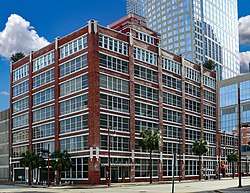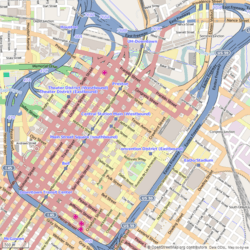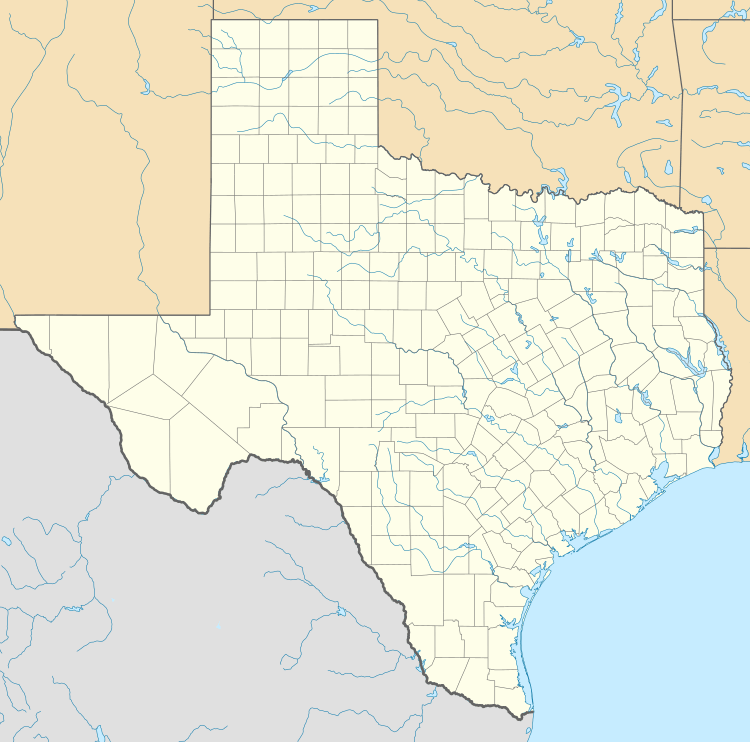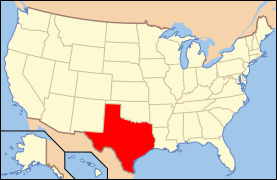Hogg Building
The Hogg Building, also known as the Hogg Palace, is a building located at 401 Louisiana in Downtown Houston, Texas, and is listed on the National Register of Historic Places.
Hogg Building | |
 The building's exterior in 2011 | |
   | |
| Location | 401 Louisiana Street, Houston, Texas |
|---|---|
| Coordinates | 29°45′45″N 95°21′50″W |
| Area | less than one acre |
| Built | 1921 |
| Architect | Barglebaugh & Whitson |
| Architectural style | Late 19th and 20th Century Revivals, Mediterranean Revival |
| NRHP reference No. | 78002943[1] |
| RTHL No. | 10684 |
| Significant dates | |
| Added to NRHP | July 14, 1978 |
| Designated RTHL | 1981 |
History
The Hogg Building was known as the Armor Building during the design process[2] and the Great Southern Building when it opened in March 1921.[3] Charles Erwin Barglebaugh and Lloyd R. Whitson designed the eight-story, Sullivan-inspired building. The ground floor was used as a showroom for automobiles, while the other stories were dedicated to office space. It was constructed of concrete with reinforced steel, thus eliminating the need for a large number of piers. The building is also characterized by a great number of windows, covering much of the outer facing. Ornamentation marks the tops of the seventh and first floors.[2]
William Clifford Hogg, the eldest son of former Texas Governor Jim Hogg, used the eighth-floor penthouse to manage Hogg Brothers Company and the family's philanthropic projects.[3][4] In the 1920s, Hogg's workspace was, "surrounded by a roof garden lavishly abloom with shrubs and flowers, in a suite of elegantly furnished rooms that included an oval dining room, a kitchen, a living room, and a guest bedroom as well as offices."[4] He decorated the penthouse with his collection of artwork by Frederic Remington.[4][5] The Hogg family used the penthouse as a business office until 1941.[3]
In the early 1990s, developer Randall Davis converted the retail and office building into seventy-nine loft apartments.[6] Davis opened the refurbished building as the Hogg Palace Lofts in the fall of 1995, and it was already fully leased by the end of that year.[7]
References
- "National Register Information System". National Register of Historic Places. National Park Service. July 9, 2010.
- Henry, Jay C. (1993). Architecture in Texas, 1895-1945. Austin, Texas: University of Texas Press. pp. 66–67.
- Kirkland, Kate Sayen (2009). The Hogg Family and Houston: philanthropy and the civic ideal. Austin, Texas: University of Texas Press. p. 28.
- Bernhard, Virginia (1996). Ima Hogg: the Governor's daughter (2 ed.). New York: Brandywine Press. p. 67.
- Kirkland, p.213
- Myers, Victoria J. ("Preservation CAN work in Houston: The Humble Oil & Refining Company Building" (PDF). 6 (3). Houston History.
- Bivins, Ralph (December 20, 1995)."Lofty ambitions/Old Texaco offices selling to investors/Downtown building to get apartments". Houston Chronicle.
External links
| Wikimedia Commons has media related to Hogg Building. |
- Beachy, Debra (March 15, 1998). "Historic Buildings in Houston Getting New Roles". New York Times. Retrieved November 20, 2014.
- "Armor Building". Prairie School Traveler. Retrieved November 20, 2014.
- "Hogg Palace". Houston in Pics: Houston photo blog with a pedestrian bias. Retrieved November 20, 2014.
- "The Hogg Brothers Collection". Museum of Fine Arts, Houston. Archived from the original on July 4, 2011. Retrieved November 26, 2014.
- Arthur Lefevre, Jr., "HOGG, WILLIAM CLIFFORD," Handbook of Texas Online (http://www.tshaonline.org/handbook/online/articles/fho20), accessed November 26, 2014. Uploaded on June 15, 2010. Published by the Texas State Historical Association.

